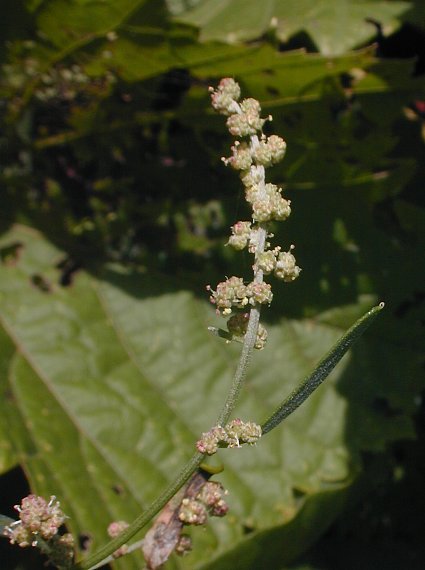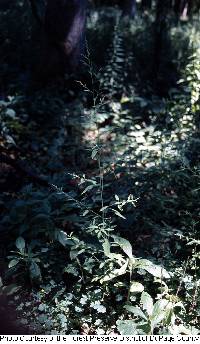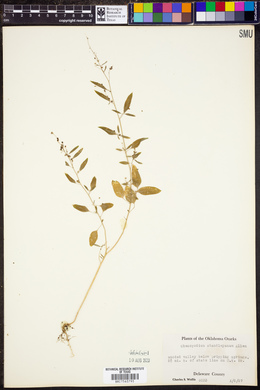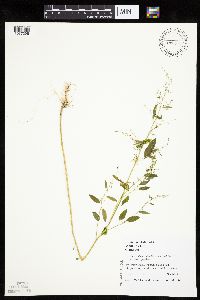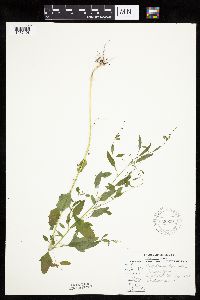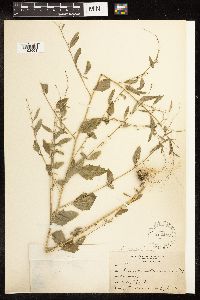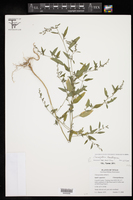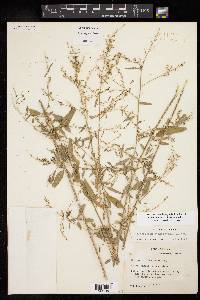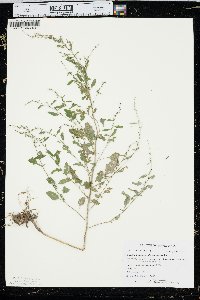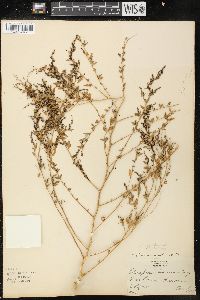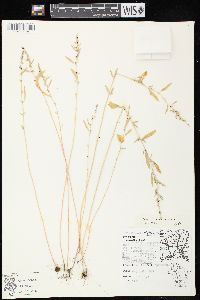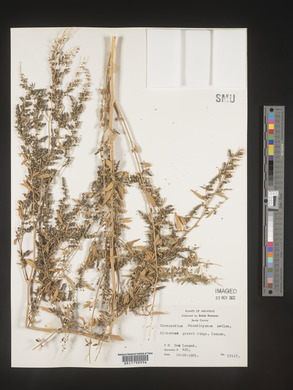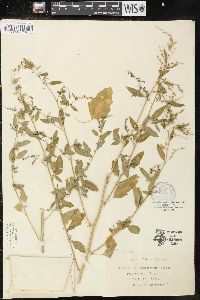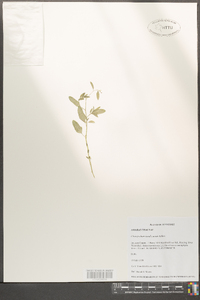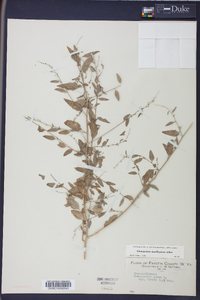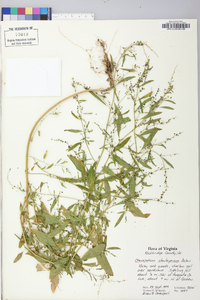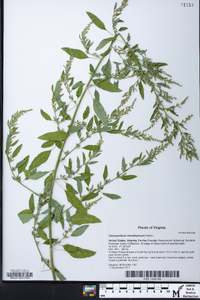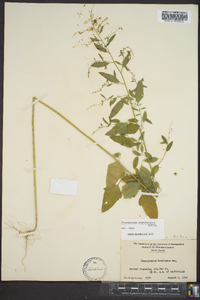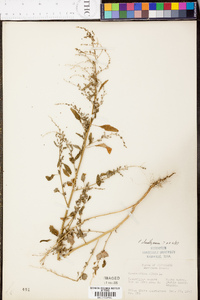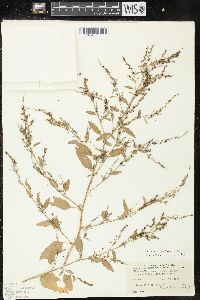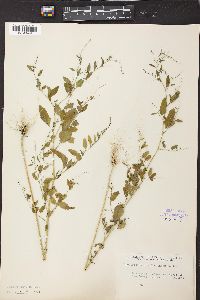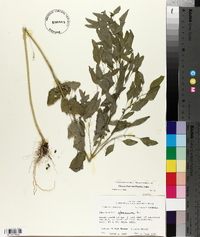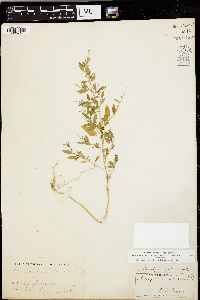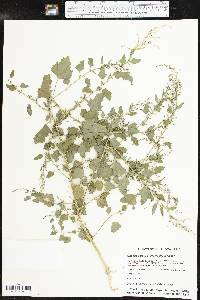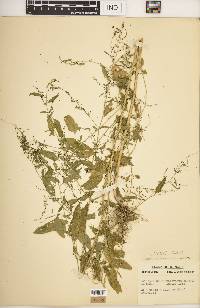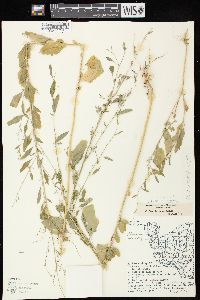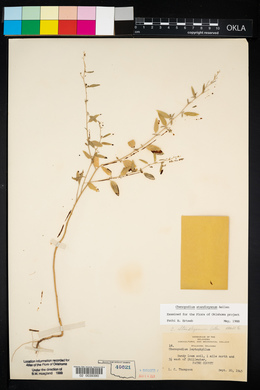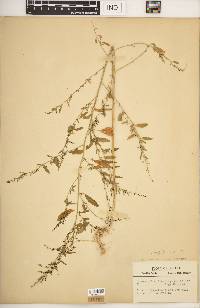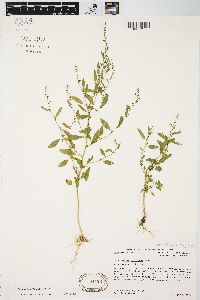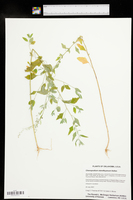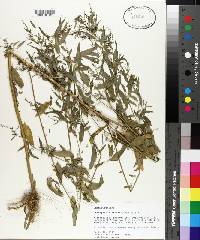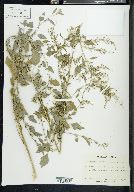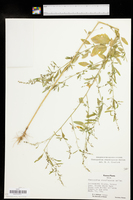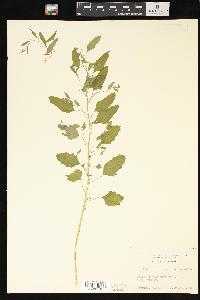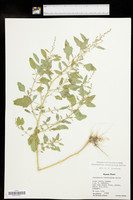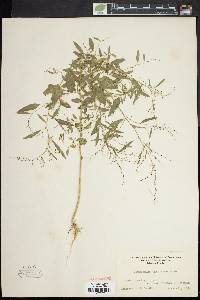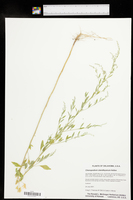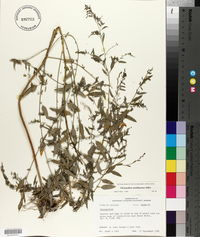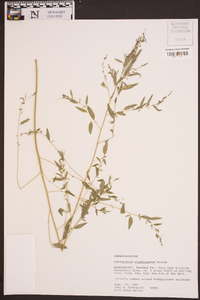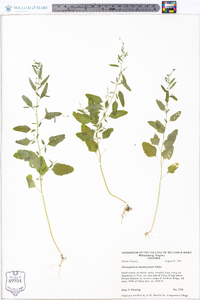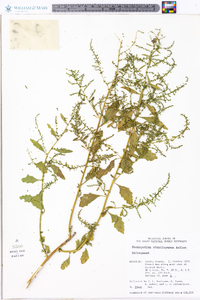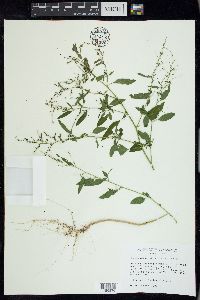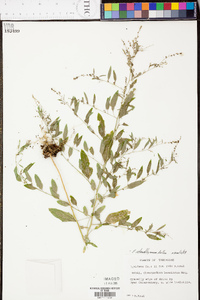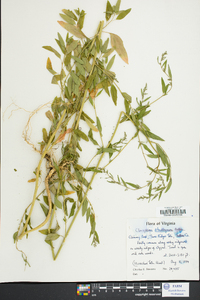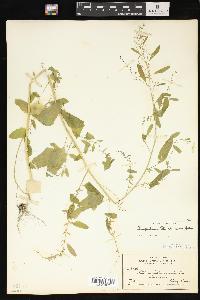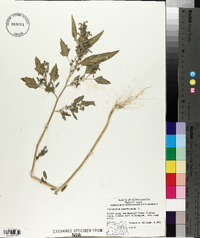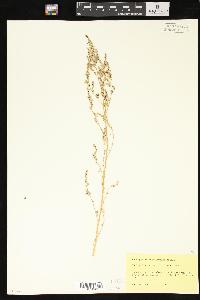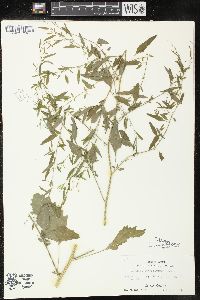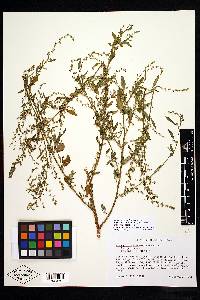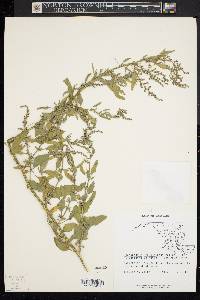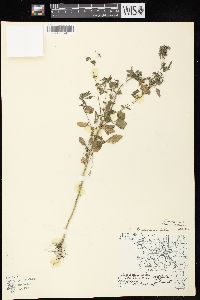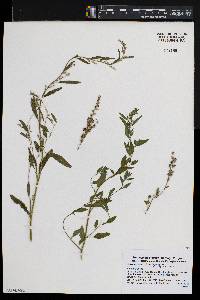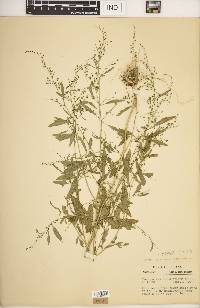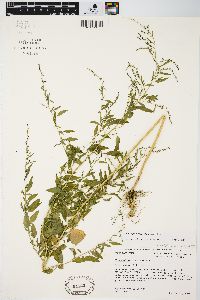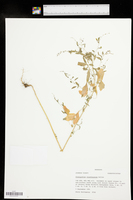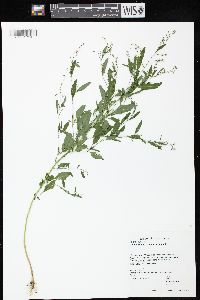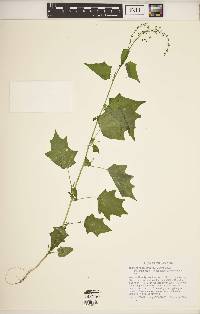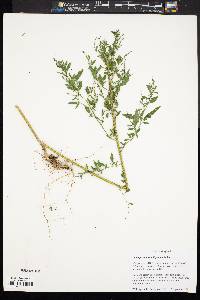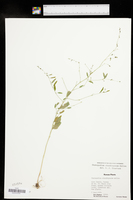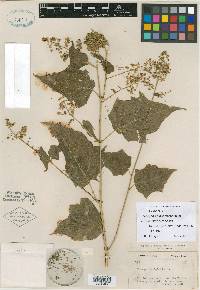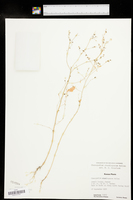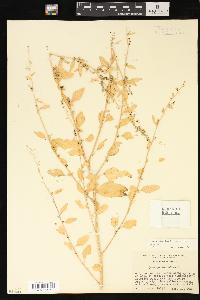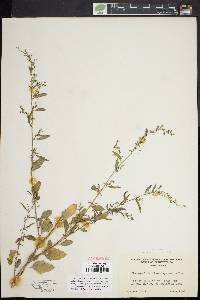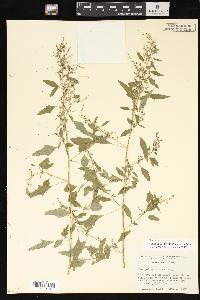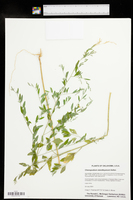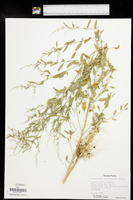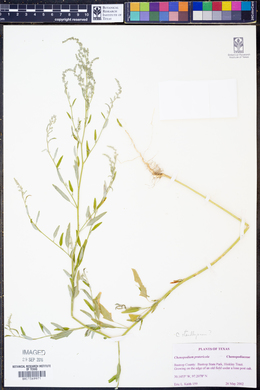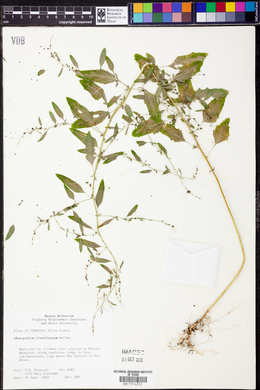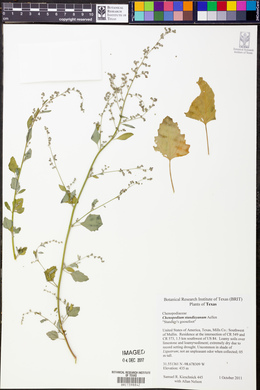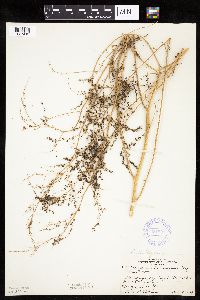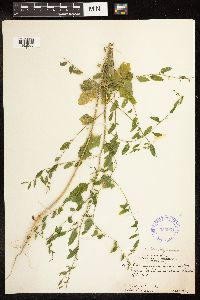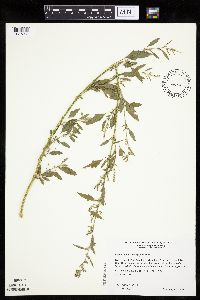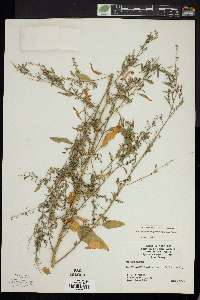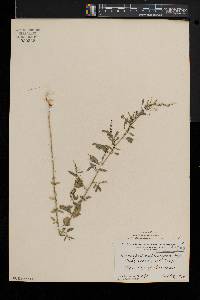
|
|
|
|
Family: Amaranthaceae
Standley's Goosefoot
[Chenopodium gigantospermum var. standleyanum Aellen, moreChenopodium hybridum var. standleyanum (Aellen) Fernald] |
Stems erect, branched, 2-6 dm, glabrous. Leaves nonaromatic; petiole 0.5-2.5 cm; blade oblong-ovoid to lanceolate, 2-4.5 × 0.5-1.5 cm, base cuneate, margins entire or proximal ones with few teeth, apex acute to acuminate, sparsely farinose. Inflorescences glomerules in terminal and lateral spikes and panicles, 6-15 cm; glomerules irregularly globose, 0.5-2 mm diam., flowers in different stages of development; bracts absent. Flowers: perianth segments 5, distinct nearly to base; lobes obovate, 0.5-0.7 × 0.5-0.7 mm, apex rounded, faintly keeled or not keeled, scarcely farinose, partly covering fruit at maturity; stamens 5; stigmas 2, 0.2 mm. Utricles depressed-ovoid; pericarp nonadherent, smooth. Seeds lenticular, margins round, 0.9-1.3 mm diam.; seed coat black, reticulate-alveolate to smooth. 2n = 18. Fruiting Sep. Shaded wooded areas in disturbed soils; elevation not known; Ont.; Ala., Ark., Conn., Del., Ill., Ind., Iowa, Kans., Ky., La., Md., Mich., Minn., Miss., Mo., Mont., Nebr., N.J., N.Y., N.C., N.Dak., Ohio, Okla., Pa., S.C., S.Dak., Tenn., Tex., Va., W.Va., Wis., Wyo. Annual herb 20 cm - 1 m tall Stem: upright to arching, branched. Leaves: alternate, on a 0.5 - 2.5 cm long stalk, 2 - 8 cm long, 0.5 - 1.5 cm wide, oblong egg-shaped to lance-shaped with a tapering base and pointed tip, thin, sometimes lower leaves bear a few teeth along the margins, sparsely white-mealy. Inflorescence: a 0.5 - 2 mm wide, irregularly round cluster of flowers (glomerule), which together form short, interrupted spikes and larger branched inflorescences (panicles) that are 6 - 15 cm long. Flowers: greenish, small, with five nearly distinct sepals and no petals. Sepal lobes about 0.5 mm long and wide, reverse egg-shaped with a rounded apex, lightly keeled or not keeled, more or less white-mealy. Stamens five. Stigmas two. Fruit: one-seeded (utricle), only partially enclosed in the persistent, incurved sepals, depressed egg-shaped, thin-walled. Wall (pericarp) not adhered to the seed, easily separated, papery, smooth. Seed horizontal, black, shiny, 0.9 - 1.3 mm wide, lenticular (lens-shaped), round-margined, wrinkled-honeycombed to smooth. Similar species: No information at this time. Flowering: June to early September Habitat and ecology: Locally frequent in sandy soils. Also found in thin woods, especially where competition has been removed. Occurence in the Chicago region: native Etymology: Chenopodium comes from the Greek words chen, meaning goose, and podion, meaning "little foot," referring to the leaf shape of some species. Author: The Morton Arboretum Erect or arching annual to 1(-2) m; lvs thin, green or sparsely mealy, lanceolate to rarely ovate, to 8 cm, acute, entire or the larger with a few low teeth, acute or cuneate at base; fls single to few in small glomerules, these forming short, interrupted spikes that are often grouped into a loose, slender, sometimes nodding panicle; cal ±white-mealy, scarcely covering the fr; pericarp smooth, papery, fragile, easily separable; seeds horizontal, black, shining, ca 1 mm wide, smooth to faintly striolate, longitudinally striolate over the radicle; 2n=18. Dry, open woods; widespread in e. U.S. and adj. Can., from s. Que. to Fla., and w. to S.D. and Tex. (C. boscianum, misapplied) Gleason, Henry A. & Cronquist, Arthur J. 1991. Manual of vascular plants of northeastern United States and adjacent Canada. lxxv + 910 pp. ©The New York Botanical Garden. All rights reserved. Used by permission. From Flora of Indiana (1940) by Charles C. Deam In sandy soil along roadsides and in open sandy woods. True C. boscianum Moq. [which Deam considers distinct from C. standleyanum] occurs in the southern states. ...... Indiana Coefficient of Conservatism: C = 5 Wetland Indicator Status: UPL Diagnostic Traits: leaves lance-ovate, to 6 cm long sparsely farinose beneath; flowers few-flowered glomerules; sepals 5, somewhat farinose; fruits horizontal; seeds about 1 mm wide, shiny, black. |
This project was made possible in part by the Institute of Museum and Library Services [MG-70-19-0057-19].
Powered by Symbiota

